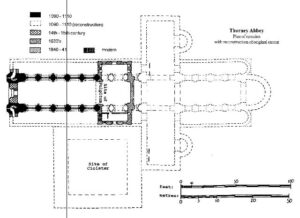Thorney Abbey
There has been a Christian site on the island of Thorney since 662 AD. It was originally a place of hermits and anchorites set amongst the marshes and water of the Fens.
The religious site is said to have been founded when Saxulf, the Abbot of Medehampstead (Peterborough) asked for some land to allow two of his monks to live a more remote and contemplative life. Wulfhere King of the Mercians granted the request.
Legends tell us their names were Tancred, and Torcred, they were among the first settlers, and their sister Tona also accompanied them to the island. As with Celtic custom they would have lived in cells attached to the church. The first church and cells would have been wooden structures and were replaced by later buildings.
In 870, the monastery was pillaged and destroyed by the Danes, some of the monks with others who had fled from Crowland survived by hiding in the woods on the island.
In 972, the Abbey was refounded by Aethelwold, Bishop of Winchester. The new foundation was to be led under the Benedictine Rule, by Aethelwold himself, then by his chaplain Godemann as Abbot.
The old Abbey Church was being replaced from 1090 onwards by Abbot Gunter, who was appointed by William the Conquerer. The annals of Thorney record for 1098 that:
“In this year on 13 November we first entered our new church of Thorney. Afterwards, on the 1st December we transferred the saints’ relics. Only the choir and two doorways and the foundations of the tower were complete”
The Abbey survived until December 1st 1539, when it was dissolved.
In 1550 John, Earl of Bedford obtained from the Court of Augmentation a grant of the farm, of the site and demense lands of Thorney monastery, which was a fairly extensive estate. By 1574 the Abbey roof had collapsed and half the steeple was down, regular processions of horse drawn vehicles were seen to be carrying away materials of wood and stone. Much of the Abbey fabric was purchased for the building of Corpus Christi college, Cambridge in 1579.
However considerable portions of the Abbey remained and still remain to this day, which is more than can be said of the great Abbey at Ramsey. (Ref 12)

